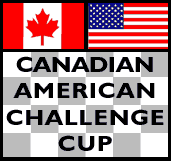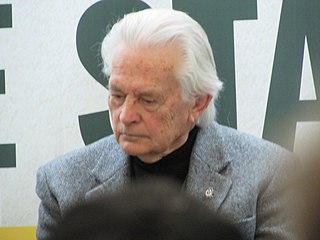Related Research Articles

The Ford GT40 is a high-performance mid-engined racing car originally designed and built for and by the Ford Motor Company to compete in 1960s European endurance racing. Its specific impetus was to best Scuderia Ferrari, which had won the prestigious 24 Hours of Le Mans race for six years running from 1960 to 1965. Around 100 cars have been made, mostly as 289 cu in (4.7 L) V8-powered Mk Is, some sold to private teams or as road legal Mk III cars. Racing started in 1964, with Ford winning World Championships categories from 1966 to 1968. The first Le Mans win came in 1966 with three 427 cu in (7.0 L) powered Mk.II prototypes crossing the finish line together, the second in 1967 by a similarly powered highly modified US-built Mk.IV "J-car" prototype. In order to lower ever-higher race top speeds, a rule change from 1968 onwards limited prototypes to 3.0 litre Formula 1 engines; a loophole, however, allowed the private JW "Gulf Oil" team win at Le Mans in 1968 and 1969 running a Mk.I with a 5.0 litre engines.
Lola Cars Limited is a British automobile manufacturer founded in 1958 by Eric Broadley in Bromley, England. The company is now owned by Till Bechtolsheimer, who purchased it in 2022. Lola Cars endured for more than fifty years to become one of the oldest and largest manufacturers of racing cars in the world. Lola started by building small front-engine sports cars, and branched out into Formula Junior cars before diversifying into a wider range of sporting vehicles. In 2012, Lola Cars stopped operations. Lola is set to make a return to motorsport in 2024 by joining the Formula E World Championship as an entrant and a powertrain supplier in a technical partnership with Yamaha.

The 24 Hours of Daytona, also known as the Rolex 24 At Daytona for sponsorship reasons, is a 24-hour sports car endurance race held annually at Daytona International Speedway in Daytona Beach, Florida. It is run on the Sports Car Course layout, a 3.56-mile (5.73 km) combined road course that uses most of the tri-oval plus an infield road course. Held on the last weekend of January or first weekend of February as part of Speedweeks, it is the first major automobile race of the year in North America. The race is sanctioned by IMSA and is the first race of the season for the IMSA SportsCar Championship.

Renzo Zorzi was a racing driver from Italy who participated in seven Formula One Grands Prix between 1975 and 1977, for the Williams and Shadow teams. He began in Formula Three while working with Pirelli before progressing to Formula One. He later raced in sports cars before returning to work with Pirelli, running a driving school. He is the only driver from the province of Trentino to have competed in Formula One.

The Canadian-American Challenge Cup, or Can-Am, was an SCCA/CASC sports car racing series from 1966 to 1974, and again from 1977 to 1987.

The World Sportscar Championship was the world endurance racing series run for sports car racing, sanctioned by the Fédération Internationale de l'Automobile (FIA), from 1953 to 1992. The championship evolved from a small collection of the most important sportscar, endurance, and road racing events in Europe and North America with dozens of gentleman drivers at the grid to a professional racing series where the world's largest automakers spent millions of dollars per year.

The Mirage Lightweight Racing Car was a family of race cars built by J.W. Automotive Engineereing (JWAE) at Slough in England, initially to compete in international sports car races in the colours of the Gulf Oil Corporation.
Group 5 was an FIA motor racing classification which was applied to four distinct categories during the years 1966 to 1982. Initially Group 5 regulations defined a Special Touring Car category and from 1970 to 1971 the classification was applied to limited production Sports Cars restricted to 5 litre engine capacity. The Group 5 Sports Car category was redefined in 1972 to exclude the minimum production requirement and limit engine capacity to 3 litres. From 1976 to 1982 Group 5 was for Special Production Cars, a liberal silhouette formula based on homologated production vehicles.

The 1968 World Sportscar Championship season was the 16th season of FIA World Sportscar Championship racing and featured the 1968 International Championship for Makes and the 1968 International Cup for GT Cars. The former was contested by Group 6 Sports Prototypes, Group 4 Sports Cars and Group 3 Grand Touring Cars and the later by Group 3 Grand Touring Cars only. The two titles were decided over a ten race series which ran from 3 February 1968 to 29 September 1968, but one race was only worth half points, and only the five best results were counted.

The Ferrari 312 PB was a Group 6 Prototype-Sports Car introduced in 1971 by Italian carmaker Ferrari. It was officially designated the 312 P, but often known as the 312 PB to avoid confusion with a previous car of the same name. It was part of the Ferrari P series of Prototype-Sports Cars but was redesignated as a Group 5 Sports Car for 1972.

The Lola B98/10 was a Le Mans Prototype built by Lola Cars International for use in the International Sports Racing Series, American Le Mans Series, and 24 Hours of Le Mans. It would be the first international sports car built by Lola since they briefly left the sport in 1992 following the Lola T92/10. It would be succeeded in 2000 by the Lola B2K/10.
Leonard Bailey was a British automobile designer.

The Lola T600 was a racing car introduced in 1981 by Lola Cars as a customer chassis. It was the first GT prototype race car to incorporate ground-effect tunnels for downforce. The revolutionary aerodynamic design of the T600 was widely imitated throughout the 1980s by International Motor Sports Association (IMSA) and Group C prototype cars. The Lola T600 ran initially in the U.S.-based IMSA GT series and later in European Group C races.

Tony Southgate is an English engineer and former racing car designer. He designed many successful cars, including Jaguar's Le Mans-winning XJR-9, and cars for almost every type of circuit racing. He was responsible for the chassis design of Ford's RS200 Group B rally car. Southgate was employed as chief designer or technical director for many Formula One teams for over twenty years. These teams included BRM, Shadow and Arrows. Southgate retired after producing the Audi R8C, which was a major influence in the Bentley Speed 8, which won Le Mans in 2003. He continues to be a regular visitor to current and historic race meetings.

The Lola T290, and its evolutions, the T292, T294, T296, T297, T298, and T299, are a series of Group 5 Sports 2000 prototype race cars, designed and developed by Bob Marston, John Barnard, Patrick Head, and Eric Broadley, and built by British manufacturer and constructor Lola, for European 2-Litre Championship sports car racing series, between 1972 and 1981.

The Monza 1000 Kilometers, was the fourth round of the 1980 World Championship for Makes was held at the Autodromo Nazionale Monza, on 27 April. This race was also the third round of the FIA World Challenge for Endurance Drivers and the fourth round of the Italian Championship Group 6.

The Lola Mk6 GT was a racing car with a production run of only three units, built between 1962 and 1963 by British car manufacturer Lola Cars. With its 289 cu in (4.74 L) Ford V8 engine, the Mk6 GT was the first mid-mounted, high displacement V8-powered Grand Touring car, a chassis arrangement that had been used, up until that time, only on formula cars and smaller, more affordable GTs.
The Lola T333CS was a race car designed and built by Lola Cars for use in SCCA Can-Am Series racing and made its racing debut in 1977. The T333CS was highly successful; winning 21 races, and 3 championships with three different drivers, between 1977 and 1979. The Lola T333CS commonly used the 5.0-litre Chevrolet V8 engine.
The Lola T98/00 is an open-wheel racing car chassis, designed and built by Lola Cars that competed in the CART open-wheel racing series, for competition in the 1998 CART season. It was unfortunately another very unsuccessful season for them, with Lola scoring no wins or pole positions that season. It was mainly powered by the 850 hp (630 kW) Ford/Cosworth XB turbo engine.

The Lola T210, and its evolution, the Lola T212, are Group 6 sports prototype race cars, designed, developed and built by British manufacturer Lola, for the newly created European 2-Litre sports car racing championship, in 1970.
References
- ↑ "Motorsport Memorial -". www.motorsportmemorial.org.
- ↑ "Capoferri M1 - Ford Profile | Racing Years". www.racingyears.com.
- ↑ "Capoferri M1 - Ford Profile | Racing Years". www.racingyears.com.
- ↑ "Capoferri M1" . Retrieved 22 June 2022.
- ↑ "Capoferri M1 - All Results - Racing Sports Cars".
- ↑ "Renzo Zorzi || The "forgotten" drivers of F1". www.f1forgottendrivers.com. September 26, 2019.